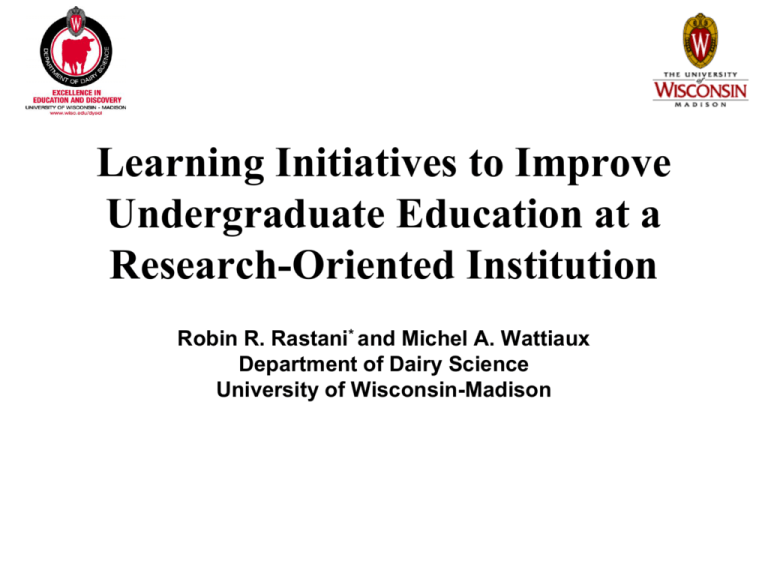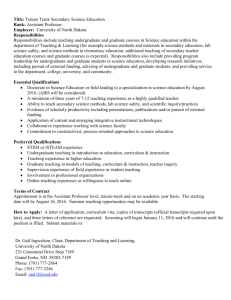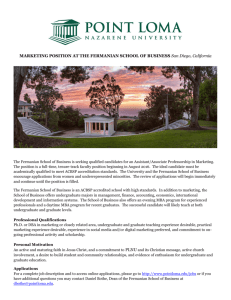Learning Initiatives to Improve Undergraduate Education at a
advertisement

Learning Initiatives to Improve Undergraduate Education at a Research-Oriented Institution Robin R. Rastani* and Michel A. Wattiaux Department of Dairy Science University of Wisconsin-Madison The Research-Oriented University • What is a research-oriented university? – “offer a full range of baccalaureate programs, are committed to graduate education through the doctorate, and give a high priority to research.” (Carnegie Foundation for the Advancement of Teaching, 1994) – 84 Research I universities and 37 Research II universities – Only 3% of higher education institutions • “The Research Universities have too often failed, and continue to fail, their undergraduate programs.” (Boyer Commission, 1998) • Can Universities be both student-centered and research-centered? Initiatives to Improve Undergraduate Education at U.W.- Madison • 28,217 Undergraduates • 2064 faculty and 1420 instructional staff • > 20 Centers and support organizations • 2 key initiatives to improve undergraduate education at U. W. Madison – Delta Program – Teaching Academy What is Delta? • Background: A multi-million $, multi-state NSF initiative (2002-2007) • Mission: to develop a national STEM (Science, Technology, Engineering, and Mathematics) faculty committed to implementing and advancing effective teaching practices for diverse student audiences as part of their professional careers • The Three Pillars (principles) are: • Learning through diversity • Teaching-centered vs. Learning centered classroom • Learning communities • Peer-support system • Teaching as research • Scholarship of teaching and learning. What does this mean for the nation? Undergraduate Education Comprehensive University 2-yr College Masters Liberal University Research Arts University 80% of faculty with Ph.D.’s Are trained at Research Univ. 100 Research Universities Nation-wide Expanding the Principles of Delta • • Example of Delta Activities (working with both graduate students and faculty): – – – – • • The directors of Delta are creating a network of research universities who will work together to prepare graduate students and post-docs with the same principles as Delta. Currently in the network: – – – – – • “regular” courses on “nuts and bolts” of course development Classroom exploration Round Table dinner (seminar) Teaching Internships University of Wisconsin Colorado State University Howard University Michigan State University Pennsylvania State University Discussions with: – Vanderbilt University – Georgia Tech University – Stanford University Delta Numbers, 2005 Participants 400 350 Delta Participants*: • 17.3% Faculty • 13.7% Instructional Staff • 13.8% Post-docs • 55.1% Graduate Students 300 250 200 CALS Participation in Delta (23.4%) • 17.4% Faculty • 17.4% Instructional Staff • 20.4% Post-docs • 44.9% Graduate Students 150 100 50 0 Total Faculty Inst. Staff Postdocs Graduate Students • 11.2% of CALS take part in Delta • 13.2% of STEM take part in Delta College of Ag. and Life Science * A participant is someone who has participated in at least one Delta activity. What is the Teaching Academy? Background: Created by UW-Madison faculty senate in 1993 (limited funds) Mission: To provide University-wide leadership to strengthen undergraduate, graduate, and outreach teaching and learning at UWMadison. Basic Functions: Provide a forum for dialogue on effective teaching and learning. Disseminate good practices of teaching and learning. Link individuals interested in improving the teaching and learning process. Sponsor professional development events. Analyze issues and make recommendations on University policies affecting teaching and learning. Teaching Academy Numbers, 2005 140 Teaching Academy Members*: • 65.1% Faculty • 12.7% Instructional Staff • 1.6% Post-docs • 20.6% Graduate Students Participants 120 100 80 CALS Participation in TA (11.6%) • 72.7% Faculty • 13.6% Instructional Staff • 4.5% Post-docs • 9.1% Graduate Students 60 40 20 0 Total Faculty Inst. Staff Postdocs Graduate Students • 1.5% of CALS take part in TA • 1.4% of UW take part in TA College of Ag. and Life Science * A member is someone who has been nominated and inducted. One Pathway through Delta/ Teaching Academy Summer 2003: Heard about Delta Program - in 3rd year of Fall 2003: 1. Took a Delta course, “Teaching in Science and Engineering” 2. Participated in Roundtable Dinners 3. Participated in graduate student discussion Ph.D. program Fall and Spring 2005: 1. Continued to participate in previous activities 2. Participated in “Creating a collaborative learning environment” Spring 2004: Continued to participate in Roundtable Dinners and discussions Selected as a Future Faculty Partner of the Teaching Academy Impact Numbers • Impact numbers are measured as number of students affected by changes in courses as a result of the programs. • Delta Program • From IMDC (Instructional Materials Development Class) and Internships • Faculty team up with graduate students to focus on improving one aspect of teaching and learning • 2004-2005 • Teaching Academy • From the Summer Institute, a week long program to assist faculty in course development, curriculum assessment, and other topics relative to teaching and learning. • 2000-2004 Impact of IMDC and Internship (Delta Program, 04 & 05) 95 % of Delta projects affect undergraduate education. School Total Undergraduate Students Impacted % of Total Students (over 2 years) Agric. & Life Sciences 90 5.0% Engineering 50 2.8% Letters & Sciences 1660 92.2% TOTAL 1800 Summer Institute Participants (Teaching Academy, 00-04) Classification of Participants Participants Participants from CALS Participants from Teaching Academy Number Percentage Number Percentage Number Percentage Faculty 62 72.1 11 91.7 16 80 Instructional Staff 21 24.4 1 8.3 3 15 Graduate Student 3 3.5 0 0 1 5 86 100.0 12 100.0 20 100 Total Impact of Summer Institute Projects by School for Undergraduate Education 88 % of Summer Institute projects affect undergraduate education. School Agric. & Life Sciences Total Undergraduate Students Impacted % of Students (over 4 years) 1576 6.0% 39 0.1% 152 0.6% 4572 17.5% 18585 71.2% Medical 5 0.0% Nursing 1776 6.8% 293 1.1% Education Engineering Human Ecology Letters & Sciences Pharmacy TOTAL 26998 * Average yearly participation in the Summer Institute = 22 Conclusions • The initiatives at UW-Madison are distinctly different, but affect undergraduate education directly and indirectly. – Participation from the College of Agriculture and Life Sciences is on par with that of other schools and colleges at the University. • Teaching initiatives at research-oriented institutions contribute in placing emphasis on undergraduate education, although their impact remains limited.






